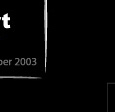The Biennial of Istanbul, opened close to the end of the 50th edition of the Venice Biennale and almost at the same time as the Biennial of Lyon, could have been overshadowed by these great events. But nothing could have been more mistaken! Descending from the famous biennials of Venice, Sao Paolo and Paris, the eighth Biennial of Istanbul has overcast all expectations through outstanding imagination and conception. Attending the event Francesco Bonami himself, the main curator of the Venice Biennial, expressed his appreciation for the excellent organization, the artists and the quality of the exhibiting techniques. Generously placed under the concept "Poetic Justice" suggested by the American art critic and senior curator at the New Museum of Contemporary Art in New York, Dan Cameron, the event had a strong artistic and emotional impact over the Old and New Istanbul. The exhibitions and panel discussions took place simultaneously in different unconventional spaces, the appeal of the main destination, Antrepo 4, (an 8000 m2 harbor storage area) being enhanced by the almost unrealistic presence of the giant transatlantic ships, anchored by the quay of the Bosphorus. The map of the Biennial included other locations - the Museum of Saint Sofia, the Yerebatan Cisterns, the former cannon factory Tophane, the Turkish Baths, a 17th c inn, and the Platform Garanti Center for Contemporary Art - which created a difficult but at the same time seductive and picturesque route.
Without the size or aura of the Biennial of Venice, the one in Istanbul was nevertheless the source of the same kind of appreciative comments regarding the quality of the works of art (focused on the established concept of the exhibition, but also outside or just touching on that concept), the importance of the curators invited for the panels (Rosa Martinez, Ute Meta Bauer, Hou Hanru, Dunja Blazevic, Sabine Vogel, Carolyn Christov-Bakargiev, Gregory Volk, etc.) and the remarkable selection of the 85 artists (from 42 countries of all continents). From the North and South-Americans Jennifer Steinkamp, Peter Sarkisian (USA), Tania Bruguera (Cuba) or Jorge Macchi (Argentina) to the Asians Kim Beom (Korea), Nalini Malano (India) and Seifollah Samadian (Iran), or from the Europeans Monica Bonvicini (Ialy), Bjorn Melhus (Germany) and Danica Dakic (Bosnia-Herzegovina) to the Africans Zarina Bhimji (Uganda) and Julie Mehretu (Ethiopia) and to the Australians Raquel Ormella and Michael Riley - they all presented works engaging directly or speculating the theme of the exhibition, using a great variety of means and trying, as a secondary purpose, to have the viewers emotionally involved. The plurality of the means of expression has shown once again the major tendency of contemporary art to impose itself through new instruments of creativity, the so called 'alternative' or 'new media', rather than through new visions. However, Dan Cameron, managed to keep a balance between traditional means and the digital ones that dominate the present, by using almost all the possibilities of communication through two and three dimensional images: drawing, engraving, painting, photomontages, prints, and wall interventions, video projections, video installations, ready-made objects, mobile, virtual or ephemeral architecture, sound environment and light sculptures, computer simulation and interactive performance. As for the genres, the nude and even more so, the portrait, have been explored without prejudice, from a psychological point of view, at the border between normal and abnormal, touching upon madness, alienation and derision, as expressions of humanity under the sign of the implacable Divine/Poetic Justice. Notable, in this respect, were the works of the Israeli Uri Tzaig (Ancient Camera), the Swede Annika Larsson (Blood) and the German Bjorn Melhus (Sometimes), or those of the North and South-American artists Marlene McCarthy (Melinda, Toni, Hope and Shanda) and Alexander Apostol (What I'm looking for) respectively. The states of excitement or dread, curiosity or interrogation have been captured at another level, by Portuguese artist Filipa César in the film ironically called Berlin Zoo, Part 2. Adjusted to the sounds recorded in a zoo, the diversity of faces and grimaces of those looking at a screen showing the train timetable, discloses in a shocking and unforgiving manner how dependent people have become on the technology and crazy speed of today's city life which is their outcome as well as the danger of degeneration to the condition of basic instincts.
Also remarkable were the series of portraits by the Iranian artist Shahram Karimi painted on imported bags of rise sewn together vertically and horizontally to form a huge 'fabric' entitled Traces. It was, in fact, a micro-history of the Iranian state, an attempt to recover a lost identity seen from the perspective of an exiled person who despite living and working in Germany has not forgotten his roots. The paintings were accompanied by a video film in which the gaze was penetrating deeper and deeper into the ruins and graves of an abandoned town, enhancing in this way the meaning and the melancholy of the discourse. Among the selection of graphic works also worth mentioning are the 495 drawings of Peruvian artist Fernando Bryce grouped under the title Atlas Peru. His images marked with inscriptions and political slogans, work as an alternative document, unspoiled by censorship, subversive and critical to the official version of history as it appears in the state archives.
Probably representing the largest number of works, video art showed in dark, soundproof micro-cells, presented in a dynamic and problamatic way the reality of contemporary society. Starting with the overpopulation of big city centers (video-installation Minibar by Turkish artist Can Altay) or sports arenas (the film of French artist Bruno Peinado - Low Re(s)volutions), continuing with the condemnation of psychological abuse (I'm living - Araya Rasdjarmrearnsook, Thailand) and violence (Game Pieces - Nalini Malani, India) up to the nightmare of a world devastated by deseases and cataclysms (News from the Near Future - Fiona Tan, Indonesia or the two simultanous film sequences by Iranian artist Seiffolah Samadian - White Station and The Art of Killing) - nothing was too much for the artists challenged by the complexity of 'Poetic Justice'.
The poetics of the works seems to have been more subtle and nuanced than we might think after a simple analysis and attempt to conceptualize them. Starting from the lyrics of Persian poet Hafiz, who presents the world with a paradisiac aura and translating the motifs of harmony to the experiments of contemporary art, Dan Cameron has pleaded (perhaps in a utopian way) for the humanization of art and recapturing of the divine in all things visible and tangible as in an almost perpetual revelation. The plea has been masterfully illustrated by the works of Tania Bruguera (729092 Bags of History/Poetic Justice), Danica Dakic (Surround), Jennifer Steinkamp (Eye Catching) or the stupefying installations of Dora Garcia (at Saint Sofia) and Mike Nelson (at Buyuk Valide Han).
Without pretending to have accomplished an extensive presentation of the event, it can be said that this year's Biennial has been not only a summa of the experiences of previous years but also an improvement in value, an opening towards the understanding of the creative act as a responsible, ambivalent gesture somewhere between substance and spirit, between good and beautiful. In addition to that it demonstrated in the eyes of the international community that the great Biennials may compete through the flexibility of selection and vision, leaving aside the old prejudice related to the differences between the center and the periphery. If last century stylistic orientations in America have been dominated by European ideologies and tendencies, it can be said that this year's Biennial of Istanbul, curated by an American was an expression of the internationalization of subjects and visual means, with a great diversity, beyond the standardized constraints of contemporary globalization.
Simona Nastac
Translation by Giorgiana Zachia
This text firstly appeared in Observatorul Cultural weekly magazine (www.observatorcultural.ro)
|
|
|
||||||||||||||||||||||||||||
 |
 |
 |
 |
 |
 |
 |
|
||||||||||||||||||||||
|
|
|
||||||||||||||||||||||||||||
|
|
|
||||||||||||||||||||||||||||
|
|
 |
|
|
||||||||||||||||||||||||||
|
|
 |
 |
 |
 |
 |
|
|||||||||||||||||||||||
|
|
|
||||||||||||||||||||||||||||
|
|
|
||||||||||||||||||||||||||||
|
|
|
||||||||||||||||||||||||||||
|
|
|
|
|
||||||||||||||||||||||||||
|
|
 |
|
|
||||||||||||||||||||||||||
|
|
|
||||||||||||||||||||||||||||
|
|
|
|
|
||||||||||||||||||||||||||
|
|
 |
|
|
||||||||||||||||||||||||||
|
|
|
||||||||||||||||||||||||||||
| |
|
|
|||||||||||||||||||||||||||
|
|
 |
|
|
||||||||||||||||||||||||||
 |
|
||||||||||||||||||||||||||||
|
|
|
||||||||||||||||||||||||||||
 |
|
||||||||||||||||||||||||||||
|
|
 |
|
|
||||||||||||||||||||||||||
|
|
|
||||||||||||||||||||||||||||
|
|
|
||||||||||||||||||||||||||||
|
|
 |
|
|
||||||||||||||||||||||||||
 |
 |
 |
|
||||||||||||||||||||||||||
|
|
|
||||||||||||||||||||||||||||
|
|
|
||||||||||||||||||||||||||||
|
|
|
||||||||||||||||||||||||||||
|
|
|
|
|
|
|
|
|
|
|
|
|
|
|
|
|
|
|
|
|
|
|
|
|
|
|
|
|
|
|